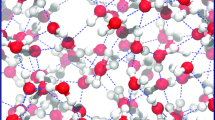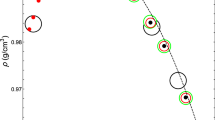Abstract
Liquid water is the most intriguing liquid in nature, both because of its importance to every known form of life, and its numerous anomalous properties, largely magnified under supercooled conditions. Among the anomalous properties of water is the seeming divergence of the thermodynamic response functions and dynamic properties below the homogenous nucleation temperature (~ 232 K). Furthermore, water exhibits an increasingly decoupling of the viscosity and diffusion, upon cooling, resulting in the breakdown of the Stokes-Einstein relationship (SER). At high temperatures and pressures, however, water behaves more like a “simple” liquid. Nonetheless, experiments at 400 K and GPa pressures (Bove et al. (2011) Phys. Rev. Lett., 111:185,901) showed that although the diffusion decreases monotonically with the pressure, opposite to pressurized supercooled water, a decoupling of the viscosity and diffusion, larger than that found in supercooled water at normal pressure, is observed. Here, we studied the validity of SER and different pressure-dependent thermodynamic response functions, known to exhibit an abnormal behavior upon cooling, including the density, isothermal compressibility, and the thermal expansion coefficient along the 400 K isotherm up to 3 GPa through molecular dynamics simulations. Seven different water models were investigated. A monotonic increase of the density (~ 50%) and decrease of the isothermal compressibility (~ 90%) and thermal expansion (~ 65%) is found. Our results also show that compressed hot water has various resemblances to cool water at normal pressure, with pressure inducing the formation of a new second coordination sphere and a monotonic decrease of the diffusion and viscosity coefficients. Whereas all water models provide a good account of the viscosity, the magnitude of the violation of the SER at high pressures (> ~ 1 GPa) is significantly smaller than that found through experiments. Thus, violation of the SER in simulations is comparable to that observed for liquid supercooled water, indicating possible limitations of the water models to account for the local structure and self-diffusion of superheated water above ~ 1 GPa.







Similar content being viewed by others
References
Speedy RJ, Angell CA (1976) J Chem Phys 65:851. https://doi.org/10.1063/1.433153
Debenedetti PG (2003) J Phys Condens Matter 15:R1669
Gallo P, Amann-Winkel K, Angell CA et al (2016) Chem Rev 116:7463
Denbenedetti P, Stanley H (2003) Phys Today 56:40
Stillinger FH (1980) Science 209:451
Lascaris E (2016) Phys Rev Lett 116:125701
Sastry S, Debenedetti PG, Sciortino F, Stanley HE (1996) Phys Rev E 53:6144
Poole L (1881) Cat Orient Coins British Museum 10:1875
Li Y, Li J, Wang F (2013) Proc Natl Acad Sci 110:12209
Debenedetti PG, Sciortino F, Zerze GH (2020) Science 369:289
Palmer JC, Martelli F, Liu Y, Car R, Panagiotopoulos AZ, Debenedetti PG (2014) Nature 510:385
Liu L, Chen SH, Faraone A, Yen CW, Mou CY (2005) Phys Rev Lett 95(11):117802
Sellberg JA, Huang C, McQueen TA et al (2014) Nature 510:381
Kim KH, Späh A, Pathak H et al (2017) Science 358:1589
Starr FW, Sciortino F, Stanley HE (1999) Phys Rev E 60:6757
Dehaoui A, Issenmann B, Caupin F (2015) Proc Natl Acad Sci 112:12020
Galamba N (2016) J Phys Condens Matter 29:015101
Chen S-H, Mallamace F, Mou C-Y et al (2006) Proc Natl Acad Sci 103:12974
Becker SR, Poole PH, Starr FW (2006) Phys Rev Lett 97:055901
Mazza MG, Giovambattista N, Stanley HE, Starr FW (2007) Phys Rev E 76:031203
Kawasaki T, Kim K (2017) Sci Adv 3:e1700399
Dueby S, Dubey V, Daschakraborty S (2019) J Phys Chem B 123:7178
Dubey V, Erimban S, Indra S, Daschakraborty S (2019) J Phys Chem B 123:10089. https://doi.org/10.1021/acs.jpcb.9b08309
Kumar P, Buldyrev S, Becker S, Poole P, Starr F, Stanley H (2007) Proc Natl Acad Sci 104:9575
Dubey V, Kumar N, Daschakraborty S (2018) J Phys Chem B 122:7569. https://doi.org/10.1021/acs.jpcb.8b03177
Dubey V, Maiti A, Daschakraborty S (2020) Chem Phys Lett 755:137802
Dueby S, Daschakraborty S (2022) Chem Phys Lett 806:140059
Dueby S, Dubey V, Indra S, Daschakraborty S (2022) Phys Chem Chem Phys 24:18738. https://doi.org/10.1039/D2CP02664C
Dubey V, Dueby S, Erimban S, Daschakraborty S (2019) J Indian Chem Soc 96:741
Dubey V, Dueby S, Daschakraborty S (2021) Phys Chem Chem Phys 23:19964. https://doi.org/10.1039/D1CP02202D
Bove L, Klotz S, Strässle T, Koza M, Teixeira J, Saitta A (2013) Phys Rev Lett 111:185901
Holz M, Heil SR, Sacco A (2000) Phys Chem Chem Phys 2:4740. https://doi.org/10.1039/B005319H
Kenneth TG, DC D, MJR H (1972) J Chem Phys 57(12):5117–5119
Berendsen HJC, Grigera JR, Straatsma TP (1987) J Phys Chem 91:6269. https://doi.org/10.1021/j100308a038
Wang L-P, Martinez TJ, Pande VS (2014) J Phys Chem Lett 5:1885
Mahoney MW, Jorgensen WL (2001) J Chem Phys 114:363
Lamoureux G, Harder E, Vorobyov I, Roux B, MacKerell A (2006) Chem Phys Lett 418:245. https://doi.org/10.1016/j.cplett.2005.10.135
Horn HW, Swope WC, Pitera JW et al (2004) J Chem Phys 120:9665. https://doi.org/10.1063/1.1683075
Abascal JLF, Vega C (2005) J Chem Phys 123:234505. https://doi.org/10.1063/1.2121687
Martínez L, Andrade R, Birgin E, Martínez J (2009) J Comput Chem 30:2157
Berendsen H, Hess B, Lindahl E, Van Der Spoel D, Mark A, Groenhof G (2005) J Comput Chem 26:1701
Euplb ML, Dtlhp LG (1995) J Chem Phys 103:8577
Tinte S, Stachiotti M, Phillpot S, Sepliarsky M, Wolf D, Migoni R (2004) J Phys Condens Matter 16:3495
Kassir Y, Kupiec M, Shalom A, Simchen G (1985) Curr Genet 9:253
Parrinello M, Rahman A (1981) J Appl Phys 52:7182. https://doi.org/10.1063/1.328693
Daivis PJ, Evans DJ (1994) J Chem Phys 100:541
Paul WB (1993) Adv Mater 5:223
Chen T, Smit B, Bell AT (2009) J Chem Phys 131:246101. https://doi.org/10.1063/1.3274802
Haile JM (1992) Molecular dynamics simulation: elementary methods. Wiley, Heidelberg
Nosé S, Klein ML (1983) Mol Phys 50:1055. https://doi.org/10.1080/00268978300102851
Heyes DM (1994) Phys Rev B 49:755. https://doi.org/10.1103/PhysRevB.49.755
Galamba N, Nieto de Castro CA, Ely JF (2004) J Phys Chem B 108(11):3658–3662. https://doi.org/10.1021/jp036234x
Allen MP, Tildesley DJ (2017) Computer simulation of liquids. Oxford University Press, Oxford
Wiryana S, Slutsky LJ, Brown JM (1998) Earth Planet Sci Lett 163:123
Abramson EH, Brown JM (2004) Geochim Cosmochim Acta 68:1827
Abramson EH (2007) Phys Rev E 76:051203
Kumar R, Schmidt JR, Skinner JL (2007) J Chem Phys 126:204107
Laage D, Hynes JT (2008) J Phys Chem B 112:14230
Laage D, Hynes JT (2006) Science 311:832
Luzar A (1996) Faraday Discuss 103:29
Luzar A, Chandler D (1996) Phys Rev Lett 76:928
Martiniano HFMC, Galamba N (2013) J Phys Chem B 117:16188
Galamba N (2013) J Phys Chem B 117:589. https://doi.org/10.1021/jp309312q
Chau PL, Hardwick AJ (1998) Mol Phys 93:511. https://doi.org/10.1080/002689798169195
Errington JR, Debenedetti PG (2001) Nature 409:318. https://doi.org/10.1038/3505302
Acknowledgements
This paper is dedicated to Prof. Pratim K. Chattaraj, Professor, IIT Kharagpur, who has been the source of inspiration for us. We respectfully acknowledge his seminal contribution in theoretical chemistry and celebrate his 65th birthday. Shivam, Archita, and Vikas acknowledge IIT Patna for their fellowships. N. G. acknowledges the work support by UIDB/04046/2020 and UIDP/04046/2020 centre grants from FCT, Portugal (to BioISI), by the Portuguese National Distributed Computing Infrastructure (http://www.incd.pt). S. D. acknowledges computational facility from IIT Patna.
Funding
This study was funded by FCT (CEEC/2018) (Portugal) and SERB Early Career Award (File No. ECR/2017/002335) (India).
Author information
Authors and Affiliations
Contributions
SD contributed to the methodology, analysis, and writing original draft. AM contributed to the analysis, and writing original draft, VD contributed to the methodology and analysis, NG contributed to the conceptualization, methodology, analysis, and writing original draft. SD contributed to the conceptualization, methodology, analysis, writing original draft, and supervision of the project.
Corresponding authors
Ethics declarations
Conflict of interest
The authors declare no competing interests.
Additional information
Publisher's Note
Springer Nature remains neutral with regard to jurisdictional claims in published maps and institutional affiliations.
Rights and permissions
Springer Nature or its licensor (e.g. a society or other partner) holds exclusive rights to this article under a publishing agreement with the author(s) or other rightsholder(s); author self-archiving of the accepted manuscript version of this article is solely governed by the terms of such publishing agreement and applicable law.
About this article
Cite this article
Dueby, S., Maiti, A., Dubey, V. et al. Thermodynamic response functions and Stokes-Einstein breakdown in superheated water under gigapascal pressure. Theor Chem Acc 142, 44 (2023). https://doi.org/10.1007/s00214-023-02991-0
Received:
Accepted:
Published:
DOI: https://doi.org/10.1007/s00214-023-02991-0




